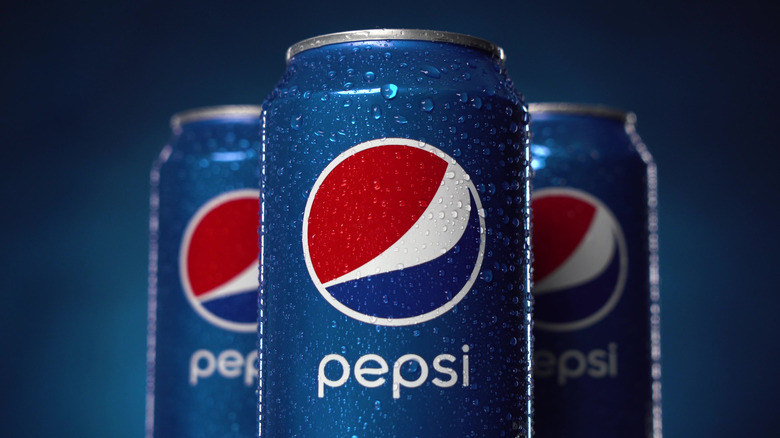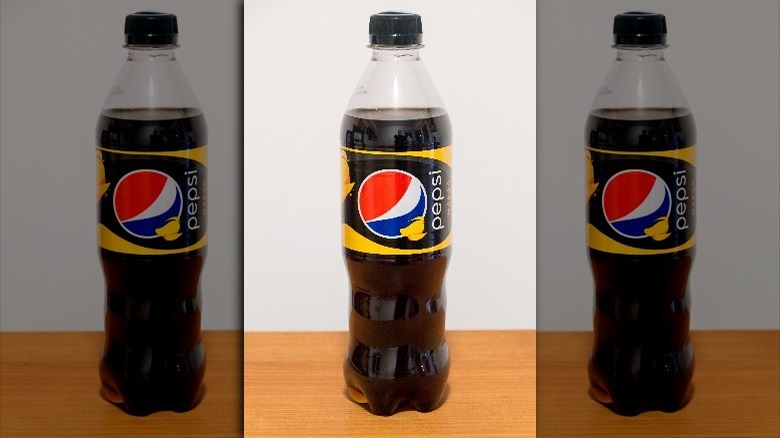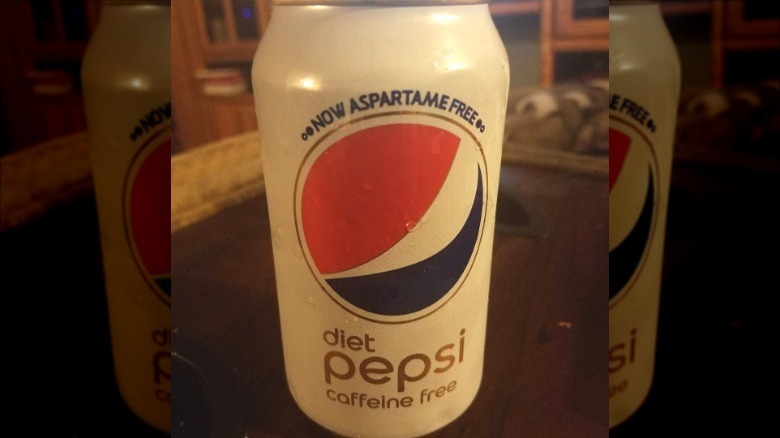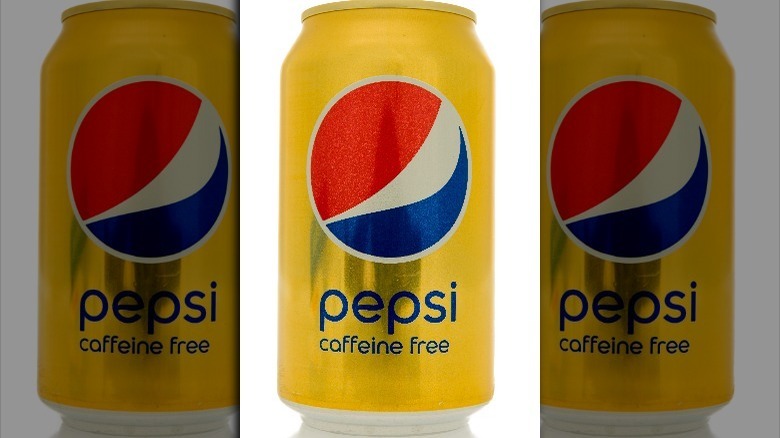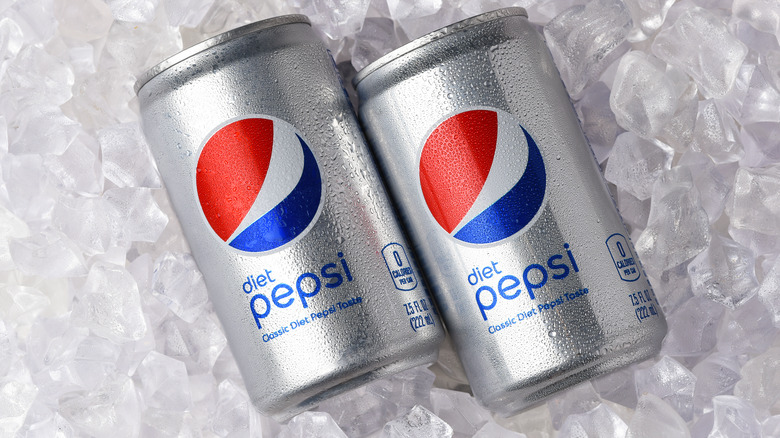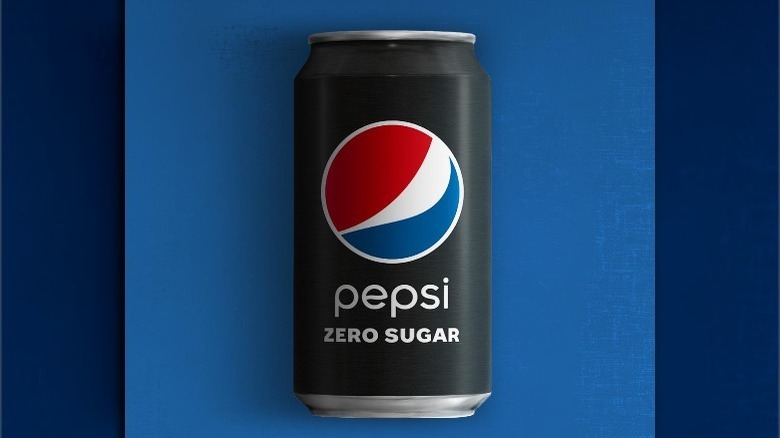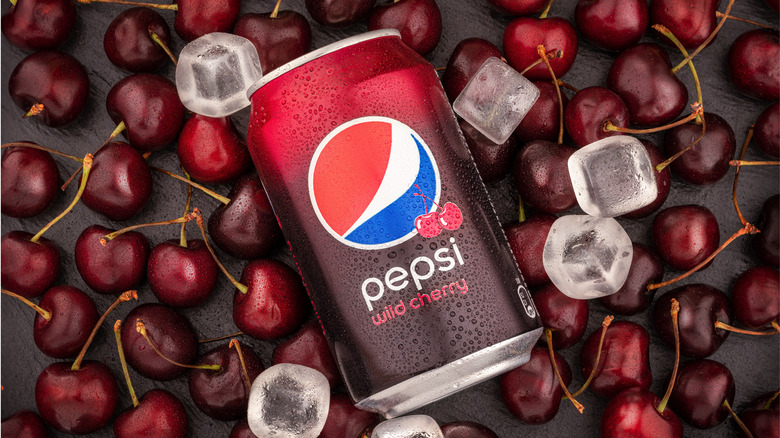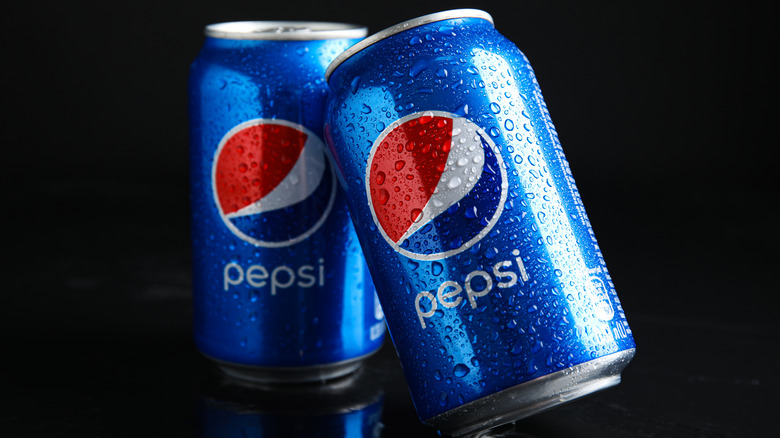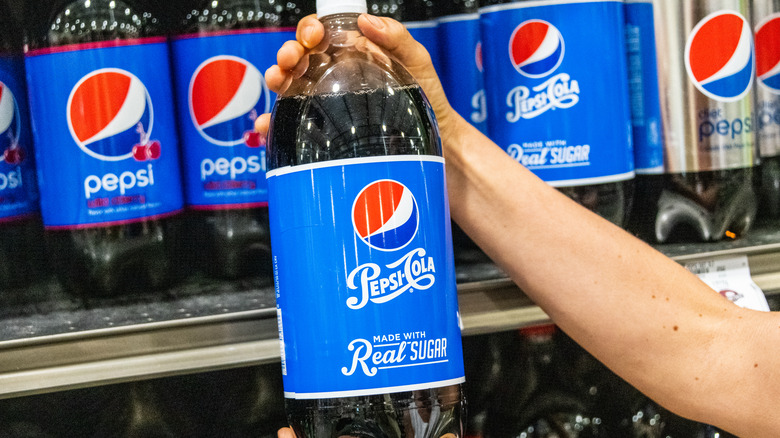Pepsi Flavors, Ranked Worst To Best
Pepsi may seem like an American stalwart now, but it wasn't always that way. Like a lot of sodas, carbonated beverages, and sweetened soft drinks, Pepsi began as a vaguely medicinal beverage in the United States of the late 1800s. Originally called "Brad's Drink" by inventor Caleb Bradham, Pepsi reportedly got its forever name because of the "pep" it provided from its combination of spicy kola nut flavoring and the powerful doses of caffeine and sugar that had been added to the mix (via History of Branding). Before long, Pepsi (as sold by PepsiCo) would go head-to-head with its number-one rival Coca-Cola for dominance of the worldwide cola market.
Pepsi introduced new products and offshoots with regularity, including diet versions, cola-fruit flavoring hybrids, seemingly improved formulations, special editions, and other drinks. Nearly all went great with burgers, for one, and were extra refreshing served cold on a hot day. They also provided a much-needed mental and physical kick when consumers needed it, at least according to the ad copy.
However, Pepsi has a long line of products, and the truth is that not all are as great as one another. These are all the varieties and flavors of Pepsi that PepsiCo currently distributes throughout the United States, ranked from worst to best.
8. Pepsi Mango
With the enduring success of cherry colas, big soda brands like Coca-Cola and Pepsi doubled down on colas with a little something extra in the early 2000s. For example, Coke and Pepsi could be found with artificial lemon, lime, and vanilla flavor added. While not all of those worked out, at least the flavor profiles had endured the test of time. After all, people had been squeezing a lemon or lime into their cola or adding in a hit of cherry or vanilla flavoring at old-fashioned soda fountains for decades.
But in 2021, Pepsi went way off the beaten path when, according to Food Business News, it added Pepsi Mango and Pepsi Mango Zero Sugar to its roster of permanent products. Now, mango isn't exactly a universally known sort of taste, at least in the United States cola market. It's a South Asian fruit with a unique, strong, and even polarizing taste. Launching Pepsi Mango and its sugar-free counterpart, Pepsi Mango Zero Sugar, was as bold as the taste of mango itself.
Oddly enough, there's not all that much actual mango flavor in either edition. The sense of it is there, though, uncomfortably clashing with the taste of cola, along with additional notes of citrus and caramel, according to KSHB. Pepsi Mango is an acquired taste, to be sure. This is a nice way of saying it doesn't taste very good upon the first sample, unlike the (for many) instantly alluring and even familiar taste of original Pepsi.
7. Diet Pepsi Caffeine Free
Diet Pepsi Caffeine Free just makes sense, doesn't it? This variety is quite possibly the most bare-bones, stimulant-free, health-conscious soft drink out there. It's got a flavor suggesting that of the classic Pepsi taste profile, but with the high-calorie sweetener removed and replaced with a sugarless, non-fattening alternative. Diet Pepsi Caffeine Free has also been stripped of the other active ingredient seen in many other Pepsi flavors: caffeine. Now, to be totally honest, Diet Pepsi Caffeine Free probably isn't healthy, or at least not in comparison to other alternatives available in grocery and convenience stores like bottled water or green tea.
Then again, it's also not strictly unhealthy either, on account of how it doesn't have any high fructose corn syrup or caffeine in it to send a person's blood sugar and heart rate through the roof. Now, there are a couple of other things that Diet Pepsi Caffeine Free lacks, too, namely a robust taste and a point of view. It just exists, offering no jolt to the system or the taste buds. It's necessarily un-filling, too, much like other diet sodas and soft drinks. But without the caffeine there to do any of the heavy lifting it just tastes like bland, lifeless, watered-down Diet Pepsi. Take a pass on this one.
6. Pepsi Caffeine Free
Pepsi Caffeine Free occupies fulfills the needs of what must be a relatively narrow sector of the soft drink market. It's the drink for people who, for whatever reason, don't wish to ingest caffeine or experience its mood-altering and awakening properties, but who also don't have any problem whatsoever with consuming a whopping amount of sugar in a single serving. Today's Pepsi Caffeine Free is the modern equivalent of Pepsi Free, introduced in 1982, according to the Washington Post. It was arguably made famous in "Back to the Future," when Marty McFly (played by Michael J. Fox) engages in a short comedy routine with a 1950s soda jerk when he asks for a "Pepsi Free" and is told that he must pay for anything he orders.
Similarly, the taste of Pepsi Caffeine Free is similarly confusing. It packs all the wallop of a regular, full-calorie Pepsi but lacks the instant caffeine jolt of its predecessor. It also tastes slightly but notably different than regular Pepsi. Ultimately, it's off the original mark by just a hair, perhaps owing to the lack of caffeine. It's a pleasant enough flavor, but it's more reminiscent of a store brand's dissonant take on Pepsi than it is anything unique.
5. Diet Pepsi
While Coca-Cola delivered on what is arguably the definitive beverage of the go-go, health-conscious 1980s by introducing Diet Coke in 1982, Pepsi was way ahead of the trend, identifying a sizable market for customers who wanted all the flavor of familiar cola-based soft drinks but without all the sugar and calories typically involved. After a brief life under the rather confusing name of Patio Diet Cola (per BBC), Diet Pepsi hit stores in 1964. Both then and now, it claimed to be everything that made Pepsi so special and tasty, and all without the dozens of grams of sugar and more than 100 calories per serving of regular Pepsi.
While the second part of the promise is strictly true, the first part regarding the taste of the diet drink is pure marketing. In fact, Diet Pepsi tastes almost nothing like regular, full-calorie Pepsi. It's clearly made from a different formula, as food scientists didn't just take out the sugar or corn syrup and plug in a calorie-free alternative without anyone noticing.
Diet Pepsi has a watery cola taste that's far from the rich and full flavor of its sugary predecessor. It does, however, leave a not totally displeasing aftertaste, which kind of feels like the caffeine punch doing its job. It also drives the drinker to keep hitting that bottle or can of Diet Pepsi, so it's not all that bad. For a diet beverage, one has to come to terms with making some sacrifices, Diet Pepsi included.
4. Pepsi Zero Sugar
It's as if the higher-ups at Pepsi and the people working in its test kitchens knew all along that Diet Pepsi was just okay. That, or it could well be that artificial sweetener technology finally advanced to the point where a giant cola company could make a sugar-free beverage that wasn't all that bad. This is to say that Pepsi Zero Sugar more closely approximates the taste of the naturally sweetened original while also offering virtually no calories. But it wasn't always known as that. As an alternative to Diet Pepsi, PepsiCo unveiled Pepsi One in 1998 (per the New York Times), a soft drink that tasted nothing like Diet Pepsi, and probably about 75 percent like real Pepsi.
Nearly a decade later (per Food Ingredients 1st), Pepsi Max became Pepsi's new diet drink of the day, made with a blend of aspartame (a sugar-free sweetener by then in wide use for decades) and a more modern sweetener called acesulfame potassium. According to KDKA, Pepsi renamed Pepsi Max as Pepsi Zero Sugar in 2016. Those new pretend sugars, stretching back through Pepsi One and Pepsi Max, did the trick for Pepsi, as did the addition of ginseng. A Pepsi Zero Sugar boasts all the rich flavor and smooth mouthfeel of a regular Pepsi, along with a major zing from the caffeine, and, perhaps because of the ginseng, a solid imitation of that zesty Pepsi formula. Of course, few will still routinely mistake it for the original.
3. Pepsi Wild Cherry
Owing to the quirks and vagaries of food science, flavorings meant to remind us of a naturally occurring fruit sometimes wind up far, far from their original inspiration. Banana candy, for example, tastes nothing like a regular banana, and cherry flavoring doesn't remind one of the taste of the cherries they might have had straight off a tree in the backyard. If anything, cherry-flavored products are oftentimes more reminiscent of grenadine syrup, that red stuff added to a Shirley Temple which was originally supposed to be pomegranate-flavored (though you'd be hard-pressed to find a genuine pomegranate grenadine on grocery store shelves nowadays). Or they might think of the bright red liquid in which maraschino cherries are packaged. At any rate, this so-called cherry flavor is still extremely sweet and dominates whatever it's mixed with, such as cola.
Pepsi's line of cherry colas is likewise dominated by that fake fruit flavor, though at least the cola taste complements and balances things surprisingly well. However, that fruit taste is so joyously powerful that it makes all three of Pepsi's cherry colas — sugar-packed Pepsi Wild Cherry, sugar-free Diet Pepsi Wild Cherry, and calorie-free Pepsi Zero Sugar Wild Cherry — taste all pretty much the same. That's no small feat, considering that all have wildly different formulas and don't all use the same sweetening agent. The end result is a surprisingly sophisticated, well-made beverage that manages to taste like a Pepsi, a cherry drink, and a non-diet drink all at once.
2. Pepsi
It's hard to top the original Pepsi, the soda that launched a million freight trucks bound for restaurants, gas stations, grocery stores, and vending machines across the land. Pepsi has been a favorite drink since the late 19th century, with plenty of die-hards who prefer it to the slightly more popular and admittedly more far-reaching Coca-Cola. And, truth be told, there's a lot to like about the original, full-sugar, full-caffeine style of Pepsi, which is still found in a familiar blue package practically anywhere you can think to look. It's fully loaded with that smooth but sparkly cola taste that's a hallmark of the brand.
But, unlike Coca-Cola or other brands, Pepsi doesn't have any sure-fire lemon or cinnamon notes to rest on. Instead, it makes up for what it lacks in that kind of flavor nuance with sweetness and a unique kick. Pepsi is pleasingly syrupy, body-chargingly sweet, with canned and bottled servings that taste similar to what one might have once gotten from an old-fashioned soda fountain. That makes for an almost mouth-puckeringly sugary mouthfeel with a vaguely lemony aftertaste that keeps drinkers coming back for sip after sip.
1. Pepsi Made With Real Sugar
How can a company that's been making sodas for more than a century improve on its flagship product, a drink beloved by all those who consume it on the regular because they love its unique mixture of cola flavor, intense sweetness, and a hint of mild spice just that much? Well, it removes the chemical-tasting sugar substitute put into the drink years ago that marred the original recipe. Some background: in 1984, per HuffPost, PepsiCo took real sugar out of the recipe for Pepsi sold in the U.S. and subbed high fructose corn syrup, an industrially-derived sweetener that is cheaper than cane sugar. But after a successful test in 2009 under the name Pepsi Throwback, PepsiCo permanently reintroduced a specialty version of Pepsi, Pepsi Made With Real Sugar, in 2014.
And, as the retro-styled label indicates, the drink is in fact made with cane sugar, meaning it tastes quite close to what Pepsi tasted like for most of the 20th century. Modern-day imbibers can now understand how Pepsi grew into one of the world's biggest soft drink makers, as Pepsi Made With Real Sugar is delicious. It provides a more velvety mouthfeel than regular, corn syrup-laden Pepsi, as the tongue is pleasantly bombarded with molecules of authentic sweetener that please the taste buds and the pleasure receptors of the brain. And to a modern palate used to the high fructose corn syrup-sweetened Pepsi, Real Sugar Pepsi tastes a far sight more improved than the standard.
